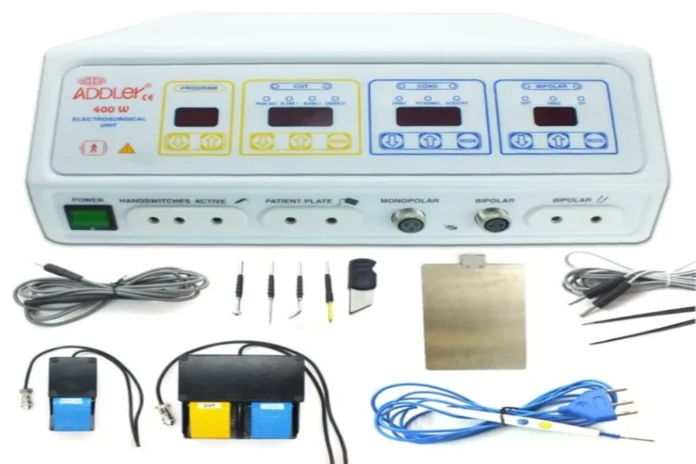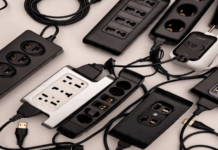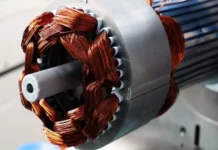If you work in the medical field, you may have heard of an electrosurgical unit (ESU).
ESUs are used to perform electrosurgery, but they can be quite complex and intimidating for those who aren’t familiar with them.
For clarity, electrosurgery is a common surgical technique that involves the use of high-frequency electrical currents to cut, coagulate, and vaporize tissue.
It is used in many different fields of medicine, including dermatology, gynecology, ophthalmology, and general surgery.
In this post, we will demystify the electrosurgical unit by providing you with a comprehensive guide on everything you need to know about this equipment
To assist you in comprehending the electrosurgical device, we will go over all the necessary information, from its parts and operations to its safety measures and troubleshooting.
Moreover, we will discuss how to use it in the operating room.
What Is An Electrosurgical Unit: Overview
With the ability to improve patient outcomes and revolutionize surgical techniques, electrosurgical units (ESUs) are an essential tool in modern medicine.
Surgeons may now undertake accurate, regulated, and minimally invasive surgical operations.
Thanks to these instruments, which have become an essential aspect of the operating room.
Essentially, electrosurgical units are electrical apparatuses that use high-frequency electric currents for tissue cutting, coagulation, and cauterization during surgical operations.
With so many advantages—including less blood loss, shorter surgical timeframes, and quicker patient recovery—the adoption of these devices has completely helped operations performance.
A generator, a handpiece, and other accessories are among the essential parts of an ESU.
At the center of the apparatus is the generator, which generates the electrical energy needed for the surgery.
To suit the unique requirements of every surgical situation, it offers a variety of waveforms and power levels.
To provide electrical energy to the target tissue, the surgeon uses a handpiece that comes with the generator.
Precision cutting, coagulation, and tissue removal are possible by the array of electrodes and instruments that come with the device
Various sizes and types of these electrodes are available, each with a distinct function in surgery.
The goal of this blog series is to explain ESUs by offering comprehensive details on their parts, modes of operation, safety factors, and recommended procedures.
All right, let’s explore this intriguing world of ESUs and discover the secrets hidden beneath this cutting-edge medical equipment.
What Is An Electrosurgical Unit: How Does An ESU Work?
For medical practitioners who use ESUs in their practice, it is essential to understand how to operate them.
Fundamentally, an ESU functions by using electrical energy to produce high-frequency AC.
This is subsequently transformed into a waveform with a greater current and lower voltage.
The radiofrequency (RF) waveform is used to describe this waveform.
Depending on the particular surgical operation, an active electrode, is usually a portable tool with different sizes and forms.
It is used to deliver the RF waveform created by the ESU. A regulated electrical circuit is created in the tissue by applying this active electrode.
Because of the resistance found in the tissue, it produces heat when you apply the RF waveform to it.
Depending on the ESU operating mode chosen, this heat causes the tissue to go through various processes.
When the ESU is in cutting mode, it sends out a continuous RF waveform that interacts with the tissue to provide a precise and regulated cutting effect.
The RF waveform produces heat, vaporizing the intracellular fluid inside the tissue, and causing it to shatter.
In contrast, the coagulation mode uses an altered radiofrequency waveform to send energy to the tissue sporadically.
By desiccating the tissue, this mechanism produces coagulation by forcing the proteins to denature and create a seal to stop the bleeding.
Aside from that, some more sophisticated ESU versions include other modes. Including mix, which combines coagulation and cutting abilities.
Bipolar mode employs two electrodes positioned near one another to reduce tissue damage and regulate bleeding in sensitive places.
In summary, with the aid of this advanced surgical instrument, surgeons can achieve optimal surgical results and make accurate incisions.
Different types of ESUs And Their Applications
To maximize surgical results and guarantee patient safety, one must have a thorough understanding of the various types of ESUs and their uses.
This knowledge enables them to select the most suitable device for each surgical procedure, ensuring optimal outcomes and patient safety.
Furthermore, proper training and adherence to manufacturer guidelines are crucial to prevent complications and ensure the safe and effective use of ESUs in the operating room.
Monopolar ESUs
This kind of ESU is the most commonly used. Three components make up this device: a generator, an active electrode, and a patient return electrode.
Due to their versatility, monopolar ESUs may be employed in a variety of processes, such as fulguration, coagulation, cutting, and desiccation.
Targeted tissue receives high-frequency electrical current from the active electrode, which completes the circuit and securely returns the electricity to the generator.
Bipolar ESUs
Unlike monopolar ESUs, bipolar ESUs use two electrodes that are both in contact with the tissue.
These electrodes are typically close together, reducing the risk of unintentional damage to surrounding tissues.
In neurosurgery and ophthalmic procedures, bipolar electro-surgical units are frequently used for precise coagulation, sealing small vessels, and dissecting delicate tissues.
Advanced Energy Devices
In recent years, advanced energy devices have emerged as an alternative to traditional ESUs.
These devices utilize different forms of energy, such as ultrasonic or radiofrequency, to achieve surgical effects.
They offer advantages like reduced thermal damage, improved sealing of vessels, and enhanced tissue dissection.
Advanced energy devices are particularly useful in procedures requiring precise tissue fusion or sealing, such as laparoscopic surgeries or vessel sealing in open procedures.
Electrosurgical Unit: Safety Measures And Precautions When Using An ESU
It is crucial to follow safety protocols and take all required safety precautions while utilizing an electrosurgical unit (ESU).
Even though it has many advantages, it is important to be aware of any possible hazards and to follow safety precautions when using it.
Following Manufacturer Guidelines
First and foremost, read the ESU’s user handbook thoroughly and strictly adhere to the manufacturer’s recommendations.
This involves getting acquainted with the device’s many settings, modes, and safety features.
Each ESU model may have its own set of recommendations and precautions, so follow them carefully.
Providing Proper Training
Workers must be properly educated about the operation of the ESU and made aware of safety precautions before using it themselves.
This applies to the surgeon, surgical team, and anybody else present in the operating room.
Regular training sessions and refreshers can assist in reinforcing safety standards and avoiding future mishaps.
Proper grounding is an important safety precaution when utilizing an ESU.
To avoid electrical shock concerns, the patient, the ESU generator, and any conductive devices must all be grounded properly.
This involves making sure that all cables, connectors, and connections are in good shape and firmly fastened.
Maintaining A Sterile Environment
Furthermore, it is crucial to create and maintain a sterile environment during ESU usage.
This includes using sterile ESU accessories, placing the ESU generator on a clean and stable surface, and keeping the surrounding area clear of any flammable materials.
Conducting Regular Inspections
Regular maintenance and inspections of the ESU are essential for optimal safety.
This includes checking for any signs of damage, loose connections, or malfunctioning parts.
If any issues are identified, the ESU should be promptly serviced or replaced to avoid potential risks during surgical procedures.
Electrosurgical Unit: Common Misconceptions And Myths About ESUs
Although electrosurgical units (ESUs) are commonly employed in a variety of medical treatments, several popular misunderstandings and fallacies persist.
To properly comprehend and efficiently use these technologies, it is necessary to dispel these myths.
One common misconception is that ESUs can cause burns or tissue damage.
While it is true that electrosurgery produces thermal energy, contemporary ESUs include cutting-edge safety safeguards to reduce the possibility of burns.
Aural alerts that notify the surgeon if the temperature rises above a predetermined level are among these safety elements, along with power control and temperature monitoring.
The danger of burns or tissue damage can be greatly decreased with appropriate technique and attention to safety procedures.
Another myth is that ESUs can interfere with other electronic devices in the operating room.
However, ESUs are designed to minimize electromagnetic interference (EMI) through shielding and grounding.
Additionally, operating rooms are equipped with EMI-resistant equipment to ensure the safe operation of all devices.
Healthcare professionals need to follow proper grounding and shielding practices to further mitigate any potential interference.
Some people also believe that ESUs can cause excessive smoke or odor during surgery.
Due to tissue vaporization during electrosurgical treatments, a tiny amount of smoke may be produced.
However, smoke evacuation devices are now standard on newer ESUs, which help to keep smoke out of the surgical field.
These devices lessen the possible health hazards related to surgical smoke while preserving the surgeon’s field of vision.
Lastly, there is a misconception that ESUs are only used for cutting and coagulation.
Although these are the main uses for ESUs, they may also be used to other processes including desiccation, fulguration, and tissue vaporization.
Because of their adaptability, ESUs enable surgeons to execute a variety of operations with control and accuracy.
Healthcare practitioners can better grasp the capabilities and safety characteristics of ESUs by dispelling these widespread myths and misunderstandings.
Their ability to employ these technologies optimally for patient benefit and to make well-informed judgments during surgical operations will be enhanced by this information.
Electrosurgical Unit: Advantages and disadvantages of using an ESU
While there are several benefits to using an electrosurgical unit (ESU) during medical operations, there are drawbacks as well.
Healthcare practitioners must comprehend these advantages and disadvantages to make well-informed judgments about their use.
Advantages
Precision and Control
An ESU’s capability to deliver accurate surgical cuts and coagulation is one of its main benefits.
Targeted tissue removal and little harm to neighboring areas are made possible by the surgeons’ ability to adjust the electrical current’s depth and strength.
Reduced Bleeding
The ESU’s ability to coagulate small blood vessels during surgery helps minimize bleeding.
This can lead to clearer visibility for the surgeon, reducing the risk of complications and improving patient outcomes.
Faster Healing
The use of an ESU can lead to quicker recovery periods than more conventional surgical techniques.
Tissue is carefully cauterized, which speeds up wound closure and lowers infection risk.
Versatility
ESUs are versatile tools that can be used in various surgical procedures across different medical specialties.
Whether it’s for cutting, coagulating, or ablating tissue, the ESU offers a multifunctional approach, reducing the need for multiple instruments.
Disadvantages
Thermal Damage
The possibility of heat injury to nearby tissues is one of the possible disadvantages of employing an ESU.
When the device is used carelessly or inexperiencedly, it might cause accidental burns that damage surrounding buildings and may even become more complicated.
Smoke and Odor
Tissue vaporization during an ESU’s operation might result in smoke and other unpleasant smells.
The surgical team may find this uncomfortable, and extra ventilation systems or safety measures may be needed to maintain a secure atmosphere.
Electrical Interference
Monitors and pacemakers are among the electronic devices that may experience interference from the high-frequency electrical current utilized in ESUs.
To reduce the possibility of electrical interference during surgical procedures, careful planning and cooperation are required.
Cost and Maintenance
ESUs can be expensive to purchase and maintain.
The initial investment, along with routine maintenance and replacement of parts, can add to the overall cost of using this equipment in healthcare facilities.
Healthcare providers can decide whether to use electrosurgical equipment in their offices by carefully considering the benefits and drawbacks.
For ESU usage to yield the most possible advantages and minimize any potential hazards, it is imperative that appropriate training be received and that safety requirements be followed.
Electrosurgical Unit: Maintenance And Troubleshooting Tips For ESUs
Electrosurgical units (ESUs) require maintenance and troubleshooting to be properly working and long-lasting.
Prompt troubleshooting and routine maintenance can help avert possible problems and guarantee continuous operation throughout surgical operations.
Here are some vital pointers to maintain the best possible condition for your ESUs:
1. Regular Cleaning
As directed by the manufacturer, properly clean the ESU after every usage.
Clear away any residue or debris to avoid accumulation that can impair function and perhaps jeopardize patient safety.
2. Calibration and Testing
Maintain accuracy and dependability by calibrating the ESU regularly.
Conduct routine checks to ensure proper operation of all functions, including cutting, coagulation, and power output modes.
3. Inspect Cables and Accessories
Check the electrodes, cables, and other attachments often for wear, damage, or fraying.
As soon as possible, replace any broken parts to guarantee secure and effective operation.
4. Grounding Verification
To reduce the possibility of an electrical shock, make sure the ESU is properly grounded.
Make sure that the grounding pad is installed and operating appropriately.
5. Power Supply and Electrical Safety
Check that the ESU’s power supply is within the necessary voltage range.
Power wires and connections should have regular inspections performed to look for wear or damage.
To reduce the possibility of electrical risks, use the correct electrical safety procedures.
6. Troubleshooting Guidelines
Learn how to troubleshoot using the manufacturer’s offered directions.
These tips can assist you in quickly recognizing and resolving frequent problems.
If you are still having trouble, get help from a skilled technician or the manufacturer.
7. Regular Servicing
Make an appointment for routine service and maintenance with licensed professionals to make sure all parts are operating at their best.
This includes inspecting cooling systems, internal electronics, and other crucial components.
What Is An Electrosurgical Unit: Frequently Asked Questions

Yes, electrosurgery is regarded as safe when performed by qualified medical experts in compliance with accepted standards.
However, using electrosurgical equipment carries some possible dangers and problems, just like any other surgical treatment.
If not handled correctly, they can result in burns, tissue damage, and electrical shock.
To protect patient safety, healthcare professionals must follow safety procedures and obtain the appropriate training.
Indeed, electrosurgical units are often utilized for minor operations in outpatient clinics and surgical institutions.
From biopsies to wart removals, they may be used for a variety of surgical procedures because of their accuracy and low invasiveness.
Depending on the treatment and the surgeon’s desire, there are different ways available, even though electrosurgical devices are a popular and successful tool in the surgical context.
Examples include radiofrequency ablation, laser surgery, and more conventional surgical methods including scalpel-based operations.
The particular approach chosen will depend on the type of operation and the demands of each patient.
High-frequency electrical current is used by electrosurgical units (ESU) to cut tissue and stop bleeding by coagulating. Tissue damage is the outcome of a heating effect brought on by tissue resistance to the high-density current.
Nowadays, the two most common types of cauterization are chemical and electrocautery, which are both widely used to stop nosebleeds and remove warts for aesthetic purposes. Another meaning of caution is the marking of a person.
What Is An Electrosurgical Unit: Final Thoughts
Although electrosurgical units might seem daunting and complicated at first, once you know the fundamentals, you’ll discover all the advantages they have to offer.
They provide accurate and regulated surgical operations, making them indispensable instruments in the medical industry.
The electrosurgical unit enables surgeons to conduct complex treatments with ease, from tissue cutting and coagulation to the removal of undesirable growths.
By enabling quicker healing times, less blood loss, and less scarring, these devices have completely transformed the medical field.
We can recognize the remarkable improvements in patient care that electrosurgical machines bring about by deciphering their potential and clearing up any confusion.
To give their patients the best possible treatment, healthcare providers must remain up to date on technological advancements and take advantage of these cutting-edge resources.
We hope that this powerversity guide about explaining the electrosurgical unit was both educational and beneficial.
Healthcare practitioners must comprehend the intricacies of this vital medical instrument.
With this thorough description of its parts, capabilities, and safety precautions, we want to arm readers with the information they need to use an electrosurgical device safely and successfully.
Regardless of your level of experience or level of curiosity, we hope that this article has helped you better comprehend this important medical instrument.
Continue to save lives, be safe, and remain informed!
I hope this Powerversity guide meets your expectations. But, then, fill out the “Leave A Reply” form at the end of this article.
Interestingly, you may want to read other articles like this. Please visit the pages below:
What Is A Power Vent Water Heater
The Best 3D Printer For Miniatures
link.springer.com The Electrosurgical Unit: Basic Principles for Practice




